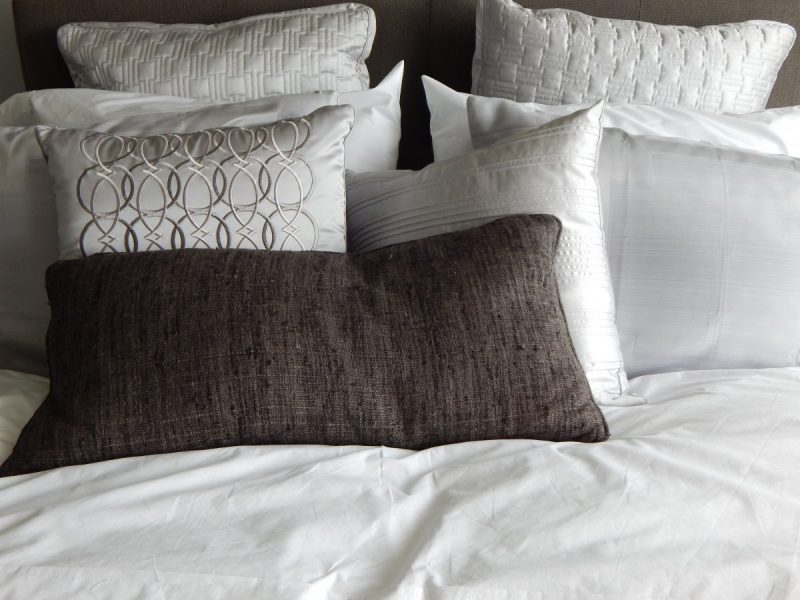You might find yourself wondering how to make a pillow cover with piping?
Well, you’re in luck since all you have to do is sew together your edges and add a bit of precision and techniques to create an embellished look. It’s not hard at all!

Pillows are not just decorations. They serve a significant purpose in assuring that we have a good night’s rest and be energized enough to start a new day.
Not only that, these sleeping tools improve mental stability, neck and back problems, and overall, our physical health.
Some may face an issue of money.
Pillows are foam-filled objects designed for utmost convenience, and they certainly don’t come off cheap for the benefits they offer.
And some might be discouraged to shell out some coins to buy the product, thus giving up a cozy sleep.
Don’t worry. All is not lost! There is still an alternative to making your pillows. That way, you can save more money and focus more on personal touches.
Sewing pillows are relatively easy, but you might find a bit of difficulty in doing a trim to finish the look. Well, you have come to the right place.
What Is Piping?
If you haven’t heard of piping, it is a technique or a sewing strategy that involves folding the edges to assume the shape of a ‘pipe.’
Sew the edge to the fabric to make a distinct line that shows the outline of the material.
Piping is popular in the Roman Catholic Church. The priests and clergymen often use these in their cassocks.
Moreover, piping served as a system to indicate their rank through the use of different colors.
Steps To Make A Pillow Cover
Here are the steps on how to make a pillow cover with piping:
Step #1. Gather
In making this product, prepare your cloth (you can decide whatever works for you), piping (we will get into this later), pillow, Regular Machine Presser Foot, a ruler, scissors, and pins.
Step #2. Measure
Of course, an important step.
A pillow cover is created base on a pillow. It is essential to use your pillow size as a foundation to ensure a perfect fit.
Otherwise, a too large or too small cover might feel uncomfy.
Height
Take the dimensions of the front part’s height and give a 1-inch allowance, and for the measurements of the backside’s size, measure and provide an inch for allowance.
Width
Another 1-inch allowance plus its dimensions for the front width and the back width, divide in half.
Once you get the quotient, add another 5 inches to get the final size.
Step #3. Piping
Procedure #1. Pin the edges
Pin the edges of each side together. The result will look like corners that outline your cloth. Leave a small area ‘unpiped.’
Procedure #2. Sew the edge
Once pinned securely, sew the edge of your pipe into the cloth. Make sure your stitches as stable and firm.
You may use a machine in sewing for convenience and faster results. When you come into a corner, keep sewing and make sure the stitches follow the corner shape.
Procedure #3. Stich the pipe together
Take the small ‘unpiped area’ and stitch it on the first pipe, and overlap.
Procedure #4. Clean your work
Cut off any excess pipes, fabric, or threads.
Make sure to avoid cutting some of your finished product. It happens sometimes.
Procedure #5. Sewing
Place the second fabric over the piped one. Pin them together and secure them in place. Afterward, stitch them up together in the seam allowances.
Make sure your stitches are tight and stable. After you’ve finished, trim the corners together to produce a more embellished look.
Turn over your finished piece. Don’t forget to insert your cushion to complete the look.
After all, it won’t be a pillow cover without a pillow. You may or may not sew a zipper to secure the opening.
Why is piping recommended when sewing pillows?
A trendy look
This technique allows the user to experiment with the looks of the pillow cover.
Piping usually results in sophisticated, elegant designs that will make people rave about your pillows.
Doing this will give your ordinary covers a complete makeover.
Easy to do
Because of its gorgeous outcome, the piping may seem like it’s hard to accomplish. But, guess what? It’s not.
Piping is one of the easiest forms of embellishments. There you have it.
You cannot achieve a personal-made pillowcase, but it also won’t take up too much of your time and effort!
Durable
The double-stitched and folded edge piping helps your pillow and pillowcase feel more durable because the corners are secured in folded material.
Corners are often the most vulnerable areas and the easiest to rip because of their exposure.
However, with this piping technique, this problem should be gone with the wind.
Conclusion
How to make a pillow cover with piping?
Pillows are a definite necessity, and if you are having the problem of making pillow covers with piping, then I hope you learned a lot.
Piping may seem unnecessary, but it provides numerous benefits and may end up helping you more than you expect.
Thanks for reading this article, and we hope that you have found the answer to your question! Enjoy sewing and make this your new favorite hobby.
